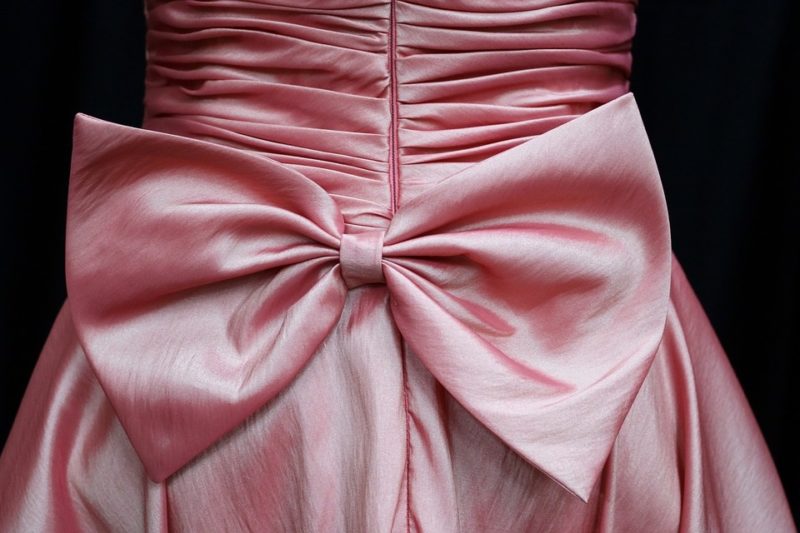The answer to what is ruching in sewing is simply a gathered fabric. We’ll talk about its purpose and how to do it in more detail below.
It’s always helpful to familiarize yourself with various sewing techniques and learn how to do them. Expanding your knowledge also allows you to be ready for every sewing project.

Feel free to browse our blog for sewing tutorials and discussions. For example, if you’re sewing a garment with ruching, you can also read about what are notches in sewing to get perfect seams.
What Does Ruching Mean In Sewing?
Ruching is a technique of gathering or scrunching the fabric piece to serve as a design or detail to a project. You’ll commonly see ruching on clothes, especially around the waistline seams, sleeves, collars, or even in accessories like hats and belts.
The effect that ruching adds is to provide a 3D effect to the fabric while also enhancing the person’s body shape. The contrast between a regular seam and a ruched side is also eye-catching and adds visual interest to the piece.
What Is The Purpose Of Ruching?
Make clothes look more flattering to the wearer
The gathered fabric that resulted from ruching makes the clothing more flattering to the wearer, and it was even the trend in the 80s. For example, putting it in strategic places such as the side seam of the waistline to hem can add curves to the body.
Ruching is also sometimes added on the sides of swimwear to help it enhance the look of the wearer’s shape. The sewer can always find various spots and places for the ruching to make the garment more complimentary regardless of the wearer’s natural shape.
Embellishment
The texture and uniqueness of ruche fabric make excellent focal points in sewing projects. It can be added to gowns and dresses to add variety to the plain-looking main garment.
Ruching is also a fantastic technique to make clothing with asymmetrical sides or hem. But, of course, the result is also flattering to the user since you’re putting the rippled look on the clothing in strategic places, such as at the side of the legs or front of the thighs in skirts.
How Do You Do Ruching?
- Mark or outline the area of the fabric that you need to ruche
- Determine the distance you want for your ruching stitch lines, remembering that this distance determines how full the ruching will look
- Set the sewing machine to the straight stitch and long stitch setting, with the thread remaining open on the stitching line ends
- After sewing the ruching lines, pull on the thread ends you left to scrunch the fabric
- Pin the gathered ruching folds to keep the scrunched material from flattening
- Sew over the ruche with a smaller stitch
- Backstitch in the beginning and end of your stitches to secure and keep the stitches from unraveling
If your sewing machine is Brother, here’s a tutorial on how to backstitch on a Brother sewing machine. It should also apply to other brands.
How To Sew Ruching With Cord
If you’re adding ruched fabric as embellishment, do these steps:
- Cut a fabric strip one and a half inches wide and length according to your needs plus half an inch for the seam allowances on the top and bottom
- Flip the fabric strip so the wrong side faces you, and press the edges by ¼ inch
- Put the fabric right side up on where you’ll add the ruching
- Sew around the strip with one end open and sew until the middle with ¾ inch of gap at the closed end
- Attach a safety pin to the cord and insert it accordingly to the casing you made
- Pull the cord to ruche and cut the excess cord
- Tie the cord ends or stitch to secure
The fabric strip is also the casing of the garment. Read what is casing in sewing to know more.
What Is The Difference Between Ruching And Shirring?
Shirring is different from ruching because it gathers several rows of fabric with an elastic thread while ruching creates a more equally distributed rippled fabric strategically placed around the garment. Shirring is also not the same as smocking where the sewer gathers material with a hand embroidery stitch.
Another way to differentiate ruching from shirring is that ruching creates a fuller look. In contrast, shirring allows stretch, so the user will have a more body-hugging silhouette when wearing the shirred clothing.
Gathering vs ruching
Ruching is a technique of gathering fabric to add volume, but gathering itself can shorten the material. It’s also usually done on one side only, so the other side looks fuller.
Another way to distinguish gathering from ruching is the technique of doing them. You’ll make basting stitches to gather fabric and then draw the bobbin thread up, while ruching is essentially leaving thread ends open then pulling them to scrunch up the material.
Read what is smocking in sewing if you want to gather the fabric and provide elasticity.
Conclusion
Was this article helpful? We just learned what is ruching in sewing: gathering the fabric to add volume strategically and make the clothing more flattering and visually attractive.
Ruching is also not the same as shirring or smocking, which gathers the fabric and provides elasticity for a form-fitting finish. We hope you understood our easy-to-follow tutorial for ruching; leave us a question below if you have any.
